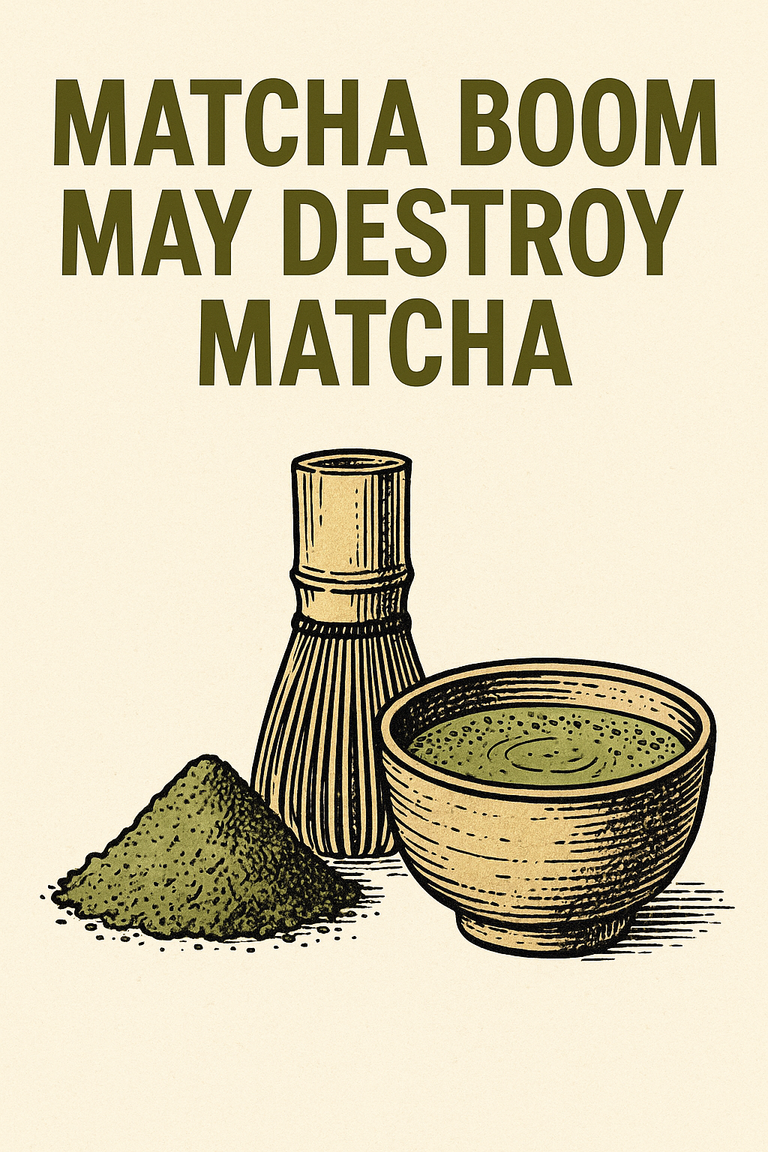Matcha Boom May Destroy Matcha

Matcha is booming. Demand climbs every year, both inside and outside Japan, but recently, it’s begun to spiral. A surge of influencer-driven hype is sending global interest through the roof, and Japanese producers simply can’t keep up. In response, some are now limiting availability.
See a story about the issue here.
The problem isn’t something that can be solved with more tea plants and extra hands. Producing true, high-quality matcha is an incredibly complex process that takes years to master. Apprenticeship often lasts a decade.
Why so long? Let’s walk through the steps.
- Shading: Several weeks before harvest, the tea plants are shaded. This boosts chlorophyll, reduces catechins (which cause bitterness), and increases L-theanine — contributing to matcha’s signature umami and vibrant green hue.
- Selective Harvest: Only the youngest, most tender leaves are picked. Older or coarser leaves are avoided, as they ruin the fine texture and delicate flavor.
- Steaming: Within hours of harvest, the leaves are lightly steamed for 15–20 seconds. This halts oxidation, locks in nutrients, and helps preserve the rich green color and grassy aroma.
- Drying and De-stemming: After air-drying, the leaves are carefully de-stemmed and de-veined. This removes tough fibers and leaves only the soft leaf tissue. Since matcha is consumed whole — not steeped — this step is crucial. The product at this stage is called tencha (碾茶).
- Grinding: The tencha is stone-ground with traditional granite mills, turned slowly to avoid heating the tea. Faster, industrial grinders exist, but they damage the flavor and aroma, so they’re used only for low-grade matcha.
- Sealing: Once powdered, the matcha is highly sensitive to light, heat, air, and moisture. It’s sealed in lightproof, airtight containers — often flushed with nitrogen — to preserve freshness, color, and nutrition.
As you can see, none of this is easy. It’s no surprise that even in Japan, quality matcha comes at a high price. In fact, you might compare it to high-end bourbon in the US: limited, artisanal, increasingly sought-after — and in many cases very, very expensive for the best grades.
Unlike bourbon, you can’t scale matcha production quickly. Even if you began training a new generation of tea artisans today, it would be years before they could match the skill and knowledge needed to meet surging demand. That doesn’t help much in the short term.

One of the comments on the article above hits the nail on the head:
It’s always amusing when people claim to love matcha but go straight for strawberry or white chocolate “matcha” concoctions.
If you really appreciate matcha, you’d respect its unique bitterness and complex umami rather than masking it with sugary flavors that turn it into a dessert gimmick.
It’s like saying you love coffee but only drinking caramel frappes — you’re not tasting the real thing, just candy in disguise.
Exactly. Coffee has gone down the same road. Starbucks helped make it fashionable to sip a sugar bomb with a splash of coffee, and now most “coffee drinks” are barely recognizable as coffee. Matcha is sliding into that same fate. I wonder how much of this new demand is for real matcha, and how much is for something that just tastes sweet and green. When it’s buried in sugar and dairy, does it even matter whether it’s ceremonial grade or low-end dust? You’re paying for image, not taste. But as Agassi reminded us decades ago: Image is everything.[1]
It reminds me of the broader issue of overtourism — too much love can ruin the thing people came for. From Kyoto to Venice, we’re seeing treasured places and practices strained to the breaking point. Matcha’s facing a similar pressure.
But that’s a post for another day.
For now, here’s that story again if you want to dig deeper.
-
Though to be fair, Agassi later admitted he hated that ad campaign — and the wig he was forced to wear. ↩
❦
 |
David is an American teacher and translator lost in Japan, trying to capture the beauty of this country one photo at a time and searching for the perfect haiku. He blogs here and at laspina.org. Write him on Mastodon. |
Yikes! My best friend and I have been drinking matcha for 8 years. These influences can go away and leave the matcha to people who aren't just trying to get views. :(
I've been drinking it even longer than you and I feel the same way!
I can't say as though I have ever had matcha. It sounds interesting and I know there is a lot of hype around it, but I don't typically purchase premium drinks in general like that.
Real matcha with no sugar is kind of like regular green tea, but even more bitter. I love it. It's definitely worth a try if you ever get the chance.
I will have to keep an eye out for it. I am sure they probably have it at the local tea house near where I live, but I still haven't made it there yet.
I like how you explained this. Very interesting.
Glad you enjoyed it.
The matcha hype is currently huge, at least here in Europe/Germany. I'm not a huge fan of matcha, I prefer a chai or chai latte.
Chai is good too, but for pure bitterness, matcha is hard to beat.
Bleh! I tried matcha once.. and once is enough for me.. i don't see how anyone likes that taste. Maybe it would taste ok with lots of sugar.. 😝😎🤙
haha many people say that. You have to like bitter tastes. I do, so I love matcha. Before I had kids and could afford to buy it more often, I made myself a cup every morning.
its all good! 😋😉👍
Your article often makes me reflect more deeply on what I constantly feel. A "boom" often destroys the original good things, like tourism, housing, food, entertainment, and more. Before these crazy booms, simple and natural movements were enjoyed by people living in harmony with nature. However, as your article says, everything is becoming matcha, matcha, matcha, and it’s becoming so difficult to produce... I think we’ve forgotten about the seasons. Seasonal food used to offer us such precious moments. I do love matcha though... 🍵
Yep, I completely agree with you!
Before I had kids I used to buy matcha powder and make it myself everyday. I became pretty good at mixing it with the chasen. I loved it so much. But now I can't really afford it so I rarely buy any.